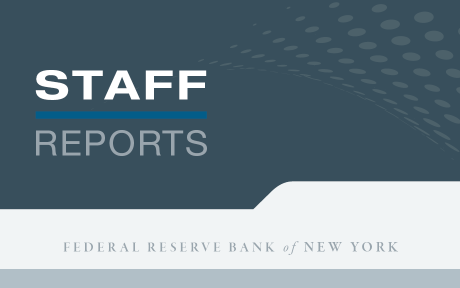
Decentralized Finance, or DeFi, is a rapidly growing ecosystem of financial applications built on blockchain technology, primarily on the Ethereum network. These applications aim to recreate traditional financial instruments and services, such as lending, borrowing, trading, and insurance. The DeFi intermediation chain connects a series of intermediaries who find arbitrage opportunities, aggregate transactions into blocks, validate these blocks, and ultimately append them to the blockchain. In this post, we summarize results from our staff report describing how arbitrage opportunities arise in the Ethereum blockchain, and how the need to keep these arbitrage opportunities private gives rise to the intermediation chain.
Blockchain Networks Are Far from Frictionless
On a blockchain network, a large number of pseudonymous nodes distributed across the world must reach consensus on which transactions are valid and which ones are not, while preventing double spending and ensuring the correct execution of a large array of smart contracts. The distributed and permissionless nature of this network prevents transactions from being processed in real time. Instead, transactions must be batched together into blocks, and the blocks must be validated to ensure that all transactions are correct, that smart contracts are properly executed, and that there is no double spending. Transactions are considered executed only if they are part of a block that has been appended to the blockchain.
These frictions in blockchain networks give rise to the DeFi intermediation chain, which connects a series of intermediaries who specialize in different aspects of block production. Throughout the different levels of this chain, intermediaries compete to obtain a share of the arbitrage profits that are constantly generated in the DeFi ecosystem.
Understanding the DeFi intermediation chain is not just an intellectual curiosity. Ethereum ETFs have recently been approved by the SEC. If Ethereum ETFs gain traction, traditional asset managers would become key participants in the DeFi intermediation chain that we examine in this post. As the lines between traditional finance and DeFi continue to blur, understanding the dynamics of intermediation in decentralized markets becomes increasingly relevant for both academics and practitioners seeking to navigate this evolving landscape.
The Origin of DeFi Intermediation: The Need for Privacy
The most basic type of transaction on the Ethereum is a payment transaction: a transfer of ETH (the native cryptocurrency on Ethereum) from one address to another. The transaction includes the sender’s address, the recipient’s address, the amount of ETH to be transferred, and a transaction fee (usually referred to as the gas fee) paid to the network for processing the transaction. In addition to ETH transfers, Ethereum allows for the transfers of other cryptocurrencies, including stablecoins and governance tokens of DeFi platforms.
Ethereum also allows users to perform more complex smart contract transactions. Smart contracts are self-executing programs that can facilitate, verify, and enforce the terms of an agreement. Transactions that interact with smart contracts can include multiple steps, such as invoking contract functions, exchanging tokens, or conditional transfers based on predefined rules. These transactions require more gas fees and have a higher level of complexity compared to simple cryptocurrency transfers. Examples of smart contract transactions include decentralized exchange trades, lending platform transactions, and complex financial agreements.
For most cases, Ethereum users want their payment transactions to be processed immediately. In order to achieve this, they broadcast their payment transactions to the entire network of nodes, hoping that it will get appended to the blockchain by the next block proposer, and appended as soon as possible.
On the other hand, there are several reasons why Ethereum users may want to keep their smart contract transactions more private. Because Ethereum allows so many different decentralized finance applications, arbitrageurs are constantly identifying mispricings across different DeFi protocols or between centralized and decentralized exchanges. By executing trades that take advantage of these price discrepancies, arbitrageurs can earn profits while helping to improve market efficiency and liquidity. Arbitrageurs who identify profitable block building opportunities must keep their transactions confidential until they are added to the blockchain to avoid being front-run by competitors using sophisticated AI-powered tools.
The DeFi Intermediation Chain
This need for privacy in smart contract transactions has led to the emergence of specialized intermediaries known as block builders. When an arbitrageur discovers a profitable trade, they don’t necessarily broadcast it directly to all Ethereum nodes. Instead, they can send their transaction directly to a trusted block builder who aggregates multiple transactions into a block with a large number of other transactions. The block builder keeps the arbitrageur’s trade private until the block is appended to the chain, at which point the transaction is executed and publicly revealed.
To ensure their transaction is included, the arbitrageur typically pays an additional fee or direct payment to the block builder. The total value generated by adding the block to the blockchain, referred to as the Maximal Extractable Value (MEV), consists of the arbitrageur’s profits, transaction fees paid to the block builder, and any direct payments made to incentivize the block builder to include the transactions.
The separation between arbitrageurs and builders is driven by economies of scale: a high-revenue block will have a high number of non-arbitrage transactions, and a small (frequently zero) number of arbitrage transactions. Block builders specialize in maintaining hardware and software that constantly aggregate these transactions to produce high value blocks. Arbitrageurs on the other hand focus on finding a small number of high-value arbitrage transactions that they can pass on to block builders.
The next layer in the DeFi intermediation chain consists of block proposers. These proposers are randomly selected through a proof-of-stake consensus mechanism, in which the probability of being chosen is proportional to the amount of cryptocurrency they have staked. The block builders compete to create the most profitable block and submit it to the proposer along with a bid. The proposer then selects the winning block to be appended to the blockchain.
A key factor driving proposer-builder separation is to maintain privacy for the arbitrageurs. If a proposer could see the contents of a block before selecting it, they might be able to identify and replicate profitable arbitrage opportunities, thus reducing the incentive for arbitrageurs to participate in the system. By only revealing the contents of the block after it has been selected, proposer-builder separation helps to protect the privacy of the arbitrageurs’ transactions and maintain the economic incentives that drive the DeFi ecosystem.
As the proof-of-stake consensus mechanism implies that block proposers with more staked cryptocurrency are chosen more consistently, the proposers run large staking pools where cryptocurrency holders pool their assets into, with many of these pools consisting of large centralized exchanges. These pools then share the profits earned from proposing blocks with the individual investors. As such, the cryptocurrency holders constitute the final layer of the intermediation chain and proposers act as “delegated stakers” for them.
This multi-layered intermediation chain connects arbitrageurs with ETH holders, while preserving the privacy of the arbitrageurs’ transactions. Each intermediary is compensated for its role, with profits flowing from the arbitrageurs to the block builders, then to the block proposers, and finally to the individual ETH depositors in staking pools or exchanges.
Summing Up
Despite the permissionless nature of blockchain technology, the need for privacy and efficient risk-sharing has led to the formation of the DeFi Intermediation Chain and the concentration of market power among a few intermediaries. Of the 167 known block builders, over half of all builder revenue and blocks proposed is captured by three builders. Similarly, out of more than 150,000 proposers, the top five staking pools or exchanges account for more than 50 percent of proposer revenue and blocks added to the chain.

Pablo Azar is a financial research economist in Money and Payments Studies in the Federal Reserve Bank of New York’s Research and Statistics Group.
Adrian Casillas is a technical associate at the MIT Sloan School of Management.
Maryam Farboodi is the Jon D. Gruber Career Development Associate Professor and an associate professor of finance at the MIT Sloan School of Management.
How to cite this post:
Pablo D. Azar, Adrian G. Casillas, and Maryam Farboodi, “The DeFi Intermediation Chain,” Federal Reserve Bank of New York Liberty Street Economics, August 5, 2024, https://libertystreeteconomics.newyorkfed.org/2024/08/the-defi-intermediation-chain/
BibTeX: View |
Disclaimer
The views expressed in this post are those of the author(s) and do not necessarily reflect the position of the Federal Reserve Bank of New York or the Federal Reserve System. Any errors or omissions are the responsibility of the author(s).












 RSS Feed
RSS Feed Follow Liberty Street Economics
Follow Liberty Street Economics